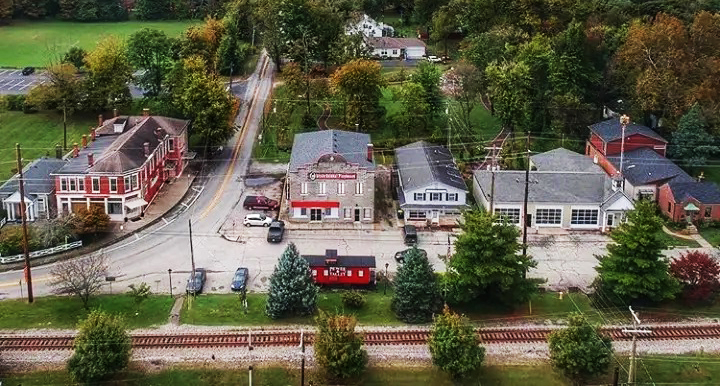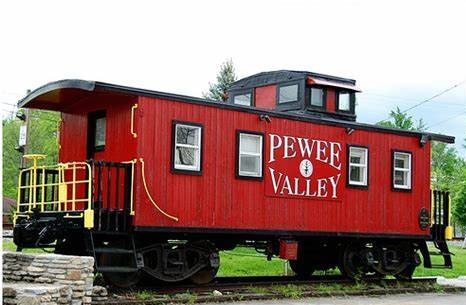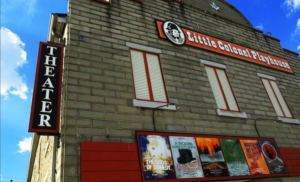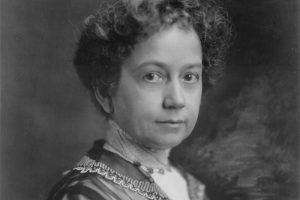
Pewee Valley, KY

The Romantic Land of the Little Colonel
 “I felt as if I had stepped back into the time when people had the leisure to make hospitality their chief business in life and could afford for every day to be a holiday, when there were always guests under the spreading rooftree of the great house, and laughter and singing…” – author Annie Fellows Johnston.
“I felt as if I had stepped back into the time when people had the leisure to make hospitality their chief business in life and could afford for every day to be a holiday, when there were always guests under the spreading rooftree of the great house, and laughter and singing…” – author Annie Fellows Johnston.
With its passenger trains and trendy train depot, Pewee Valley was not just a setting for romantic tales by Little Colonel author Annie Fellows Johnston. It was a place that resonated with the spirit of the late 18th century, a time of change and progress from railroad to automobile.
One common question is how Pewee Valley got its name. One story describes the Eastern Wood-Pewee as a mystical bird celebrating the Biblical dawn of creation with her song, “Pe-wee, Pe-wee,” but disappeared when Adam and Eve tasted the forbidden fruit. The bird did not reappear until resident Noble Butler arrived in the paradise now known as Pewee Valley.
 No matter what you believe about the name, the romance and history of the train, and the town neighbors whose real names were changed in the children’s book series The Little Colonel, Pewee Valley repeatedly calls you back to its roots. It is a super cute, quaint train town and once a sought-after luxurious country escape for the wealthy in Louisville.
No matter what you believe about the name, the romance and history of the train, and the town neighbors whose real names were changed in the children’s book series The Little Colonel, Pewee Valley repeatedly calls you back to its roots. It is a super cute, quaint train town and once a sought-after luxurious country escape for the wealthy in Louisville.
From past luxury of passenger trains, ice cream, and gossip at the depot, and the town’s main characters from the Little Colonel as your neighbor, to being the historic home of the Kentucky Confederate Home and Kentucky’s only Confederate Cemetery, Pewee Valley still has the charm, feel, and promise to take you back to a simpler time and place.

The Red Caboose
Pewee Valley, steeped in history and local pride, is home to a unique landmark, a bright red caboose. Since 1971, this beloved icon has been a friendly guidepost for locals. The story of the caboose goes beyond being a mere direction marker. It was donated by the L&N Railroad as a tribute to Charles Frith, a cherished resident and retired L&N employee. In 1971, when it arrived, it marked the grand finale of Pewee Valley’s centennial celebrations, beautifully tying the town’s rich history to its vibrant present. If you want to step back in time, visit the caboose. It sits on a short section of track that a dedicated crew of Pewee Valley residents laid.
Interestingly, it’s located where the Interurban, a historic electric railway, ran through the town from 1901 to 1934. So, when exploring Pewee Valley, watch for the charming red caboose. It’s not just a landmark; it’s a testament to the town’s heritage and community spirit!

Pewee Valley Central Park
The land on which Central Park now stands was once privately owned until much later, when it became the site for the Kentucky Confederate Home, housing wounded CSA veterans who lived there from 1902-1934. The city of Pewee purchased the property and later turned it into its city park, where a remnant of the walkway remains and serves as the entrance to the park. It is a nice little park with plenty of green space, a gazebo, wildflowers, a small bridge leading to a small pond and waterfall, and a paved trail with benches.

Saint Aloysius Catholic Church
Mission priests from the Cathedral of Louisville served the local congregation until 1863; then, a Catholic Hill cemetery was created. A small church dedicated to St. Aloysius was built on the grounds in 1865, where the parish became an official parish in 1871 and began providing missionary services to other areas.
A significant chapter in the church’s history unfolded in 1904 when they purchased more land on Mt. Mercy Drive. This marked a period of growth and expansion for our church. A new church was built and opened in 1914, symbolizing our commitment to serving the community. The original church was purchased and moved across Rollington Road, where it became a private residence. The former rectory was sold and used as a private residence on Central Avenue.
In 1926, the Sisters of Mercy arrived and established a boarding school named Mount Mercy in a house deeded to the parish by Jeremiah Bacon. The property was also used as a summer vacation home for working girls and had tennis courts, a gazebo, a swimming pool, and beautiful country scenery.

Confederate Cemetery (CSA) | Pewee Valley Cemetery
Explore a significant piece of Kentucky’s Civil War history at the Pewee Valley Cemetery, featuring the state’s only official Confederate burying ground. Walk through the CSA Cemetery, where 313 veterans rest, and learn about the Kentucky Confederate Home residents buried there. This section is one of 61 Kentucky Civil War notables on the National Register of Historic Places.
As you enter the cemetery, look out for the Kentucky Confederate Home sign, a piece of history itself. Initially marking the Home’s entrance, it now stands at the Pewee Valley Cemetery. Don’t miss the unique Zollie Tree, a descendant of the oak tree where Confederate General Felix K. Zollicoffer fell during the Battle of Mill Springs. Planted in 1985, it’s a poignant tribute to a significant figure in Kentucky’s Civil War story.
The Pewee Valley Cemetery offers more than Civil War history. Explore the 14-acre grounds and discover two additional sections, one designated for the Black population and another for the White population of Pewee Valley and the surrounding area.

Little Colonel Playhouse
The Little Colonel Players is one of the oldest community theaters in Kentucky. It was founded in 1956 with the aim of promoting the art of drama by presenting plays that are both educational and entertaining. In the first two years, members used to meet in each other’s homes to read and discuss plays and act out skits for each other. Later, they rented a space in the old Masonic Lodge upstairs in the current Playhouse to serve as a meeting place.
The group had to miss an entire season of plays while the space was being renovated. The former grocery store space was converted into an auditorium, and the stage, risers, and box office entranceway were constructed. The youth performers were the last group to perform at Valley Camp and the first to present at the new location. The renovation required hundreds of volunteer hours, and most of the work was done by LCP members. The Little Colonel Players resumed their activities in 1963.

The Little Colonel Series
“The Little Colonel” by Annie Fellows Johnston, a children’s book, was first published in 1895 and became as popular as “Harry Potter” in its time. The book’s success led to the publication of 11 more books in the “Little Colonel” series and a children’s diary, paper dolls, card games, puzzles, and postcards. In 1935, the book was adapted into a movie starring Shirley Temple, also titled “The Little Colonel.” The Pewee Valley Museum has a collection of works by Johnston, Shirley Temple dolls, memorabilia from the movie, the real Little Colonel’s baby buggy, and official postcards and toys.
Pewee Valley Museum & City Hall
Mt. Mercy Drive | Pewee Valley, KY 40056
FREE Admission Tuesday & Thursday 9am – 12noon

